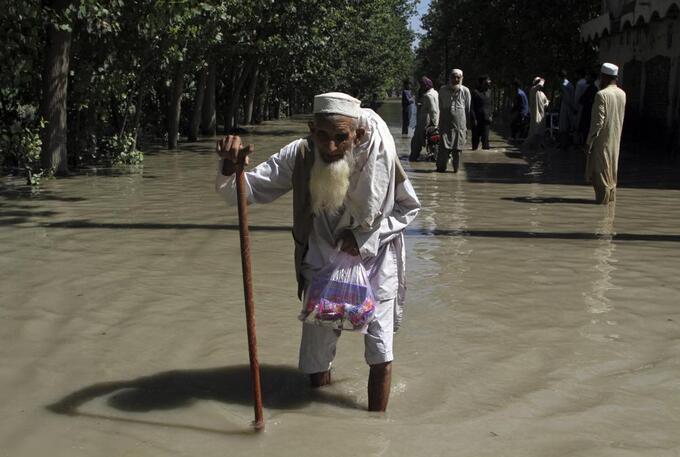May 20, 2025 | 17:54 GMT +7
May 20, 2025 | 17:54 GMT +7
Hotline: 0913.378.918
May 20, 2025 | 17:54 GMT +7
Hotline: 0913.378.918

A displaced man wades through a flooded area after fleeing his flood-hit home, on the outskirts of Peshawar, Pakistan, Aug. 28, 2022. The flooding has all the hallmarks of a catastrophe juiced by climate change, but it is too early to formally assign blame to global warming, several scientists tell The Associated Press. Photo: AP
They combined in vulnerable Pakistan to create unrelenting rain and deadly flooding.
The flooding has all the hallmarks of a catastrophe juiced by climate change, but it is too early to formally assign blame to global warming, several scientists tell The Associated Press. It occurred in a country that did little to cause the warming, but keeps getting hit, just like the relentless rain.
“This year Pakistan has received the highest rainfall in at least three decades. So far this year the rain is running at more than 780% above average levels,” said Abid Qaiyum Suleri, executive director of the Sustainable Development Policy Institute and a member of Pakistan’s Climate Change Council. “Extreme weather patterns are turning more frequent in the region and Pakistan is not a exception.”
Climate Minister Sherry Rehman said “it’s been a catastrophe of unprecedented proportions.”
Pakistan “is considered the eighth most vulnerable country to climate change,” said Moshin Hafeez, a Lahore-based climate scientist at the International Water Management Institute. Its rain, heat and melting glaciers are all climate change factors scientists warned repeatedly about.
While scientists point out these classic climate change fingerprints, they have not yet finished intricate calculations that compare what happened in Pakistan to what would happen in a world without warming. That study, expected in a few weeks, will formally determine how much climate change is a factor, if at all.
The “recent flood in Pakistan is actually an outcome of the climate catastrophe ... that was looming very large,” said Anjal Prakash, a research director at India’s Bharti Institute of Public Policy. “The kind of incessant rainfall that has happened ... has been unprecedented.”
Pakistan is used to monsoons and downpours, but “we do expect them spread out, usually over three months or two months,” said the country’s climate minister Rehman.
There are usually breaks, she said, and not as much rain -- 37.5 centimeters (14.8 inches) falls in one day, nearly three times higher than the national average for the past three decades. “Neither is it so prolonged. ... It’s been eight weeks and we are told we might see another downpour in September.”
“Clearly, it’s being juiced by climate change,” said Jennifer Francis, a climate scientist at the Woodwell Climate Research Center in Massachusetts.
There’s been a 400% increase in average rainfall in areas like Baluchistan and Sindh, which led to the extreme flooding, Hafeez said. At least 20 dams have been breached.
The heat has been as relentless as the rain. In May, Pakistan consistently saw temperatures above 45 degrees Celsius (113 Fahrenheit). Scorching temperatures higher than 50 degrees Celsius (122 Fahrenheit) were recorded in places like Jacobabad and Dadu.
Warmer air holds more moisture -- about 7% more per degree Celsius (4% per degree Fahrenheit) — and that eventually comes down, in this case in torrents.
Across the world “intense rain storms are getting more intense,” said Princeton University climate scientist Michael Oppenheimer. And he said mountains, like those in Pakistan, help wring extra moisture out as the clouds pass.
Instead of just swollen rivers flooding from extra rain, Pakistan is hit with another source of flash flooding: The extreme heat accelerates the long-term glacier melting then water speeds down from the Himalayas to Pakistan in a dangerous phenomena called glacial lake outburst floods.
“We have the largest number of glaciers outside the polar region, and this affects us,” climate minister Rehman said. “Instead of keeping their majesty and preserving them for posterity and nature. We are seeing them melt.”
Not all of the problem is climate change.
Pakistan saw similar flooding and devastation in 2010 that killed nearly 2,000 people. But the government didn’t implement plans to prevent future flooding by preventing construction and homes in flood prone areas and river beds, said Suleri of the country’s Climate Change Council.
The disaster is hitting a poor country that has contributed relatively little to the world’s climate problem, scientists and officials said. Since 1959, Pakistan has emitted about 0.4% of heat-trapping carbon dioxide, compared to 21.5% by the United States and 16.4% by China.
“Those countries that have developed or gotten rich on the back of fossil fuels, which are the problem really,” Rehman said. “They’re going to have to make a critical decision that the world is coming to a tipping point. We certainly have already reached that point because of our geographical location.”
(AP)

(VAN) Attempts to bring down the price of the Japanese staple have had little effect amid a cost-of-living crisis.

(VAN) Fourth most important food crop in peril as Latin America and Caribbean suffer from slow-onset climate disaster.

(VAN) Shifting market dynamics and the noise around new legislation has propelled Trouw Nutrition’s research around early life nutrition in poultry. Today, it continues to be a key area of research.

(VAN) India is concerned about its food security and the livelihoods of its farmers if more US food imports are allowed.

(VAN) FAO's Director-General emphasises the need to work together to transform agrifood systems.

(VAN) Europe is facing its worst outbreak of foot-and-mouth since the start of the century.

(VAN) The central authorities, in early April, released a 10-year plan for rural vitalization.